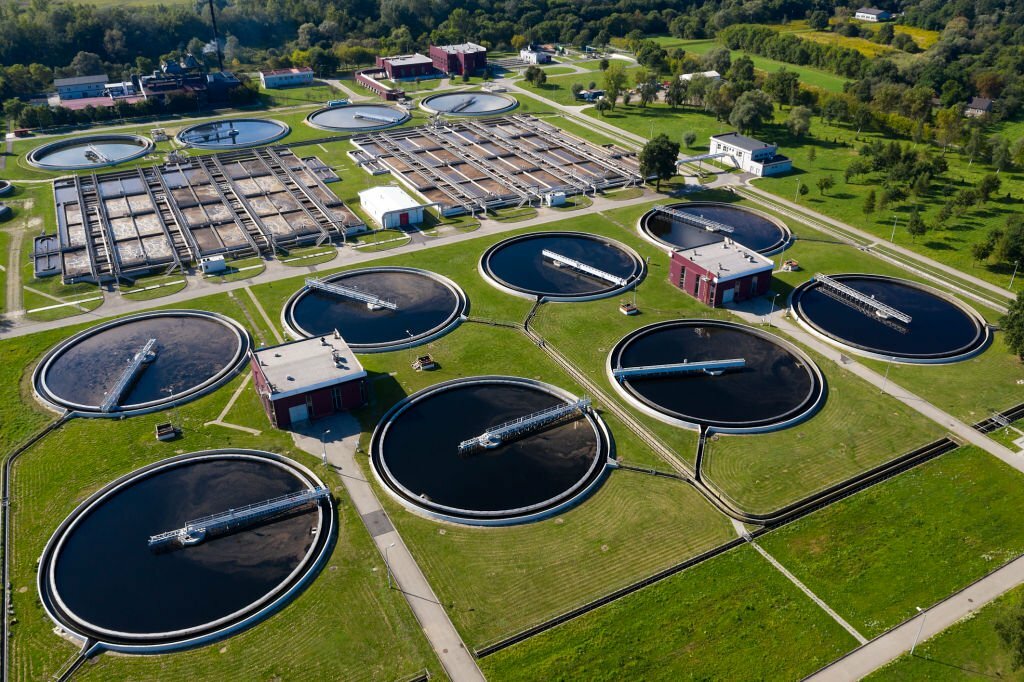In an era where environmental consciousness is at the forefront of our collective conscience, sustainable solutions are becoming increasingly vital. One area where this shift is particularly impactful is wastewater treatment. As a homeowner, commercial property owner, or industrial facility owner, It is crucial to understand sustainable sewage treatment plants.
In this article, we will explore the concept of sustainable wastewater treatment plants, delve into technological innovations in sewage treatment, and discuss how the integration of renewable energy is revolutionising these essential facilities.

What Is a Sustainable Sewage Treatment Plant?
A sustainable sewage treatment plant is designed to minimise its environmental impact while efficiently treating sewage and wastewater. Traditional plants often consume significant amounts of energy, produce greenhouse gas emissions, and may have adverse effects on the surrounding ecosystems. Sustainable models, on the other hand, employ innovative technologies and practices to address these concerns.
One key aspect of sustainability in these plants is the reduction of energy consumption. Modern plants utilise energy-efficient processes and advanced technologies to achieve this goal. Additionally, they focus on recycling and reusing treated water whenever possible, minimising the strain on local water resources.
Technological Innovations in Sewage Treatment Plant
The evolution of technology has played a pivotal role in transforming sewage treatment plants into more sustainable entities. Advanced treatment processes such as membrane bioreactors (MBRs) and sequencing batch reactors (SBRs) are gaining popularity for their efficiency in removing contaminants from wastewater. MBRs use membrane filtration to separate solids from liquid, resulting in a higher quality of treated water.
Furthermore, incorporating artificial intelligence (AI) and machine learning (ML) into sewage treatment processes has significantly enhanced efficiency. These technologies allow for real-time monitoring and optimisation of plant operations, ensuring optimal performance and resource utilisation. For example, AI-driven predictive maintenance can identify potential issues before they escalate, reducing downtime and maintenance costs.
In terms of sludge management, sustainable sewage treatment plants adopt anaerobic digestion and thermal hydrolysis processes. These methods reduce the volume of sludge and produce biogas, a valuable renewable energy source. This dual-purpose approach exemplifies the commitment of sustainable models to resource recovery and environmental stewardship.
How Is Renewable Energy Integration Revolutionizing Sewage Treatment Plants
One of the most significant advancements in sustainable sewage treatment is the integration of renewable energy sources. By harnessing the power of the sun, wind, or biogas, the plants can significantly reduce their reliance on conventional energy sources, making the entire process more eco-friendly.
Solar panels are being increasingly installed in the plants to generate electricity. These panels convert sunlight into energy, which can be used to power various components of the treatment process. This reduces the carbon footprint and cuts operational costs in the long run.
Wind turbines are another renewable energy source gaining traction in sewage treatment. Placed strategically within the plant premises, these turbines harness wind power to generate electricity. This clean and sustainable energy can power a range of equipment, from pumps to aeration systems.
Biogas, a byproduct of anaerobic digestion in sludge treatment, is a valuable renewable energy resource. Sustainable sewage treatment plants capture and utilise biogas to generate heat and electricity, decreasing their dependency on non-renewable energy sources.
Key Steps in Designing a Sustainable Sewage Treatment Plant
Site Selection:
The first crucial step in designing a sustainable plant is selecting an optimal site. The location of the facility plays a pivotal role in its overall performance and environmental impact. Factors such as proximity to water bodies, population density, and accessibility are carefully considered during the site selection process.
Choosing a site away from sensitive ecosystems helps minimise the potential harm to aquatic life and natural habitats. Additionally, selecting a location that is easily accessible ensures efficient transportation of materials and facilitates routine maintenance activities.
Comprehensive Site Analysis:
A thorough site analysis is essential to understand the specific environmental conditions and challenges that may affect the sewage treatment plant. This involves studying soil composition, groundwater levels, and meteorological data. The goal is to tailor the plant design to the unique characteristics of the site, ensuring optimal performance and longevity.
By conducting a comprehensive site analysis, engineers can identify potential risks, such as flooding or soil instability, and implement design features to mitigate these challenges. This proactive approach enhances the resilience of the plant and minimises its environmental impact.
Integrated Treatment Technologies:
The heart of any sewage and wastewater facility lies in its treatment technologies. In sustainable designs, integrated treatment technologies maximise efficiency and minimise environmental impact. Membrane bioreactors (MBRs), sequencing batch reactors (SBRs), and advanced oxidation processes are innovative technologies that enhance the removal of pollutants from wastewater.
These integrated technologies ensure effective treatment and contribute to resource recovery. Sustainable plants optimise their operations and reduce dependency on external resources by extracting valuable materials and energy from wastewater.
Energy Efficiency Measures:
Energy efficiency measures are incorporated into the design of sewage treatment plants to further enhance sustainability. Utilising energy-efficient pumps, motors, and aeration systems helps reduce the overall energy consumption of the facility. Moreover, integrating renewable energy sources, such as solar panels and wind turbines, contributes to a more eco-friendly and cost-effective operation.
Implementing energy management systems that monitor and optimise energy usage in real time is a crucial strategy. This allows for identifying areas where energy can be conserved, ultimately lowering operational costs and environmental impact.
Water Reuse and Resource Recovery:
A hallmark of sustainable plants is the emphasis on water reuse and resource recovery. Reclaimed wastewater can be used for irrigation or industrial processes instead of freshwater sources. This reduces the demand for freshwater. Advanced treatment processes, including sludge digestion and dewatering, facilitate the recovery of valuable resources such as biogas and nutrient-rich biosolids.
By closing the loop on water use and resource recovery, these plants contribute to a circular economy, promoting sustainability in the long term.
Green Infrastructure:
Incorporating green infrastructure elements into the design of sewage treatment plants enhances their environmental performance. Green roofs, permeable pavements, and vegetated buffer zones are examples of green infrastructure that help manage stormwater runoff, reduce heat island effects, and provide additional ecological benefits.
These features contribute to the sewage treatment plant’s overall sustainability and integrate the facility harmoniously into the surrounding environment.
Community Engagement & Education:
In the journey towards sustainability, community engagement, and education stand as foundational pillars in designing a sustainable wastewater treatment plant. When venturing on such projects, involving the local community ensures that their concerns are addressed and the plant aligns with their expectations. Community members gain insight into the purpose, benefits, and safety measures of the plant, fostering a sense of ownership and cooperation.
Education is pivotal in dispelling myths and misconceptions. Outreach programs can help homeowners, commercial property owners, and industrial facility managers understand the eco-friendly aspects of modern sewage treatment. By fostering a culture of environmental responsibility, communities become active partners in the success of sustainable sewage treatment initiatives.
Regulatory Compliance:
Adherence to regulatory standards is non-negotiable in the design of a sustainable sewage treatment plant. Regulatory compliance ensures that the facility meets environmental and safety standards set by local and national authorities. It also guarantees the protection of public health and the surrounding environment.
Engaging with regulatory bodies from the project’s inception helps streamline the design process. Sustainable plants are designed to meet and often exceed environmental regulations. This proactive approach ensures the smooth operation of the plant while upholding the highest standards of environmental stewardship.
Monitoring and Maintenance:
The success of a sustainable plant relies heavily on continuous monitoring and proactive maintenance. Advanced monitoring systems track the performance of key components in real-time, allowing for immediate response to any deviations from optimal conditions. Regular maintenance schedules prevent equipment deterioration and ensure the longevity of the plant.
By implementing predictive maintenance strategies, potential issues can be identified before they escalate, reducing downtime and minimising the environmental impact. This meticulous approach to monitoring and maintenance ensures that the plant operates at peak efficiency throughout its lifecycle.
Lifecycle Analysis:
In the pursuit of sustainability, considering the entire lifecycle of a sewage treatment plant is imperative. Lifecycle analysis involves evaluating the environmental impact of the plant from its construction to operation and eventual decommissioning. This holistic approach enables the identification of opportunities for improvement at each stage.
Assessing the environmental footprint includes evaluating energy consumption, resource utilisation, and waste generation. Sustainable models aim to minimise their impact at every stage, making informed decisions to reduce their carbon footprint. Lifecycle analysis is a critical tool that guides the continuous improvement of sustainable sewage treatment plant designs.
Get Sewage Treatment Plant Solutions From Experts
Elevate your approach to wastewater management by selecting our nationally acclaimed sewage treatment plants. As dedicated wastewater treatment specialists, we bring unmatched expertise and resources to assist you in utilising water wisely. Our commitment is evident in the delivery of innovative and sustainable sewage and wastewater treatment systems tailored to your diverse needs. Backed by extensive expertise and industry experience, our meticulous attention to detail ensures the reliability of our products.
Our customisable solutions are crafted to seamlessly align with the unique requirements of your project. Regardless of the complexity of your waste challenge, we stand ready to offer the highest quality, reliable, and efficient sewage treatment solutions. Embrace the first step towards a cleaner, greener future – choose our top-notch solutions.
In alignment with the Swachh Bharat mission, the installation of an efficient sewage treatment plant has become increasingly critical. That’s precisely why we present the following products to meet this imperative:
Select our cutting-edge sewage treatment solutions and contribute to a cleaner and healthier environment. Contact us at +91-9558996411 or write to us at info@cleantechwater.co.in for a custom sewage and wastewater treatment solution with full-fledged installation and maintenance services.

